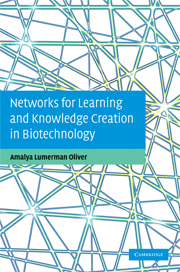Book contents
- Frontmatter
- Contents
- List of figures
- List of tables
- Acknowledgements
- Introduction
- 1 Networks, collaborations, and learning and knowledge creation
- 2 The biotechnology industry through the lenses of organizational and networks scholarship
- 3 New organizational forms for knowledge creation in biotechnology
- 4 Scientific entrepreneurship
- 5 Science and discoveries in the context of private and public knowledge creation and learning
- 6 The search for university–industry collaborations: linear and chaotic networking processes
- 7 Trust in collaborations and the social structure of academic research
- 8 Organizational learning and strategic alliances: recombination and duality of competition and collaboration
- 9 Further directions for understanding interorganizational collaborations and learning
- References
- Index
8 - Organizational learning and strategic alliances: recombination and duality of competition and collaboration
Published online by Cambridge University Press: 04 July 2009
- Frontmatter
- Contents
- List of figures
- List of tables
- Acknowledgements
- Introduction
- 1 Networks, collaborations, and learning and knowledge creation
- 2 The biotechnology industry through the lenses of organizational and networks scholarship
- 3 New organizational forms for knowledge creation in biotechnology
- 4 Scientific entrepreneurship
- 5 Science and discoveries in the context of private and public knowledge creation and learning
- 6 The search for university–industry collaborations: linear and chaotic networking processes
- 7 Trust in collaborations and the social structure of academic research
- 8 Organizational learning and strategic alliances: recombination and duality of competition and collaboration
- 9 Further directions for understanding interorganizational collaborations and learning
- References
- Index
Summary
Complexity in the concepts of competition and collaboration, and the network form of organization
The core argument in this chapter is that the study of interorganizational networks for learning and knowledge creation requires the adoption of a duality framework – collaboration or competition and the application of a prism-like methodology. By duality is meant “the quality or state of being dual or having a dual nature.” Using the concept of duality does not necessarily mean claiming that all network-based knowledge relations include competition or that competition excludes network-based knowledge relations. It simply implies that our understanding of collaboration and competition in knowledge-intensive industries, such as biotechnology, may be enhanced by applying a method of observation that allows us to reveal the spectrum of relational forms that coexist in many network-based knowledge relations. Thus, a prism-like methodology is suggested here, which may make it easier for us to seek the different “spectrums of light” that exist in network-based knowledge relations. A “prism” is defined in optics as “a piece of translucent glass or crystal used to form a spectrum of light separated according to colors. Its cross-section is usually triangular. The light becomes separated because different wavelengths or frequencies are refracted (bent) by different amounts as they enter the prism obliquely and again as they leave it.” Although the prism concept is used mainly for metaphorical purposes, it corresponds nicely to the purpose of this chapter.
- Type
- Chapter
- Information
- Networks for Learning and Knowledge Creation in Biotechnology , pp. 187 - 210Publisher: Cambridge University PressPrint publication year: 2009



